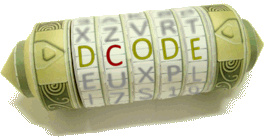Tool to decrypt / encrypt by homophonic substitution, the homophonic cipher consists of replacing each letter of the alphabet by several substitutes in order to prevent cryptanalysis by frequency analysis.
Homophonic Cipher - dCode
Tag(s) : Homophonic Substitution Cipher
dCode is free and its tools are a valuable help in games, maths, geocaching, puzzles and problems to solve every day!
A suggestion ? a feedback ? a bug ? an idea ? Write to dCode!
Homophonic Cipher
Homophonic Decoder
Answers to Questions (FAQ)
What is the Homophonic cipher? (Definition)
The homophonic cipher is a substitution cipher that uses a correspondence table between the letters / characters of the plain message and one or more letters / numbers / groups of characters.
Consequently, the same letter may have several possible encryption and the same message will possibly have several possible encrypted versions.
The homophonic cipher helps hide the frequency of letters used in a message, thus making frequency analysis more difficult for a cryptanalyst.
How to encrypt using Homophonic cipher?
To use the homophonic cipher, the user must first define a correspondence table between the plain text characters and one or more symbols for each character.
During the encryption process, randomly choose from these symbols each time a specific character needs to be encoded. This ensures that the same character is not always represented by the same symbol in the ciphertext.
Example: Using the nomenclature A(45,96,17), B(37,60), C(05,88), it is possible to code ABC as 45,60,88 or 96,60,05 or 96,37,05 etc.
To maximize encryption security, it is smart to use a number of matches per letter proportional to the frequency of the letter in the language of the clear message, and be sure to select a replacement from the list randomly.
How to decrypt an Homophonic cipher?
Use the correspondence table to transform each character / group of characters in the plain message.
Example: 34,25,10 has been coded with these multiple correspondences: A(87,34,11), B(25,80), C(10,55), the plain message is ABC
How many correspondences to use per letters?
By taking 100 numbers, the ideal match is approximately equal to the frequency of each letter in the English language (expressed as a percentage rounded to the nearest unit)
| E | 12 | T | 9 | A | 8 | O | 7 |
|---|---|---|---|---|---|---|---|
| I | 7 | N | 7 | S | 6 | H | 6 |
| R | 6 | L | 4 | D | 4 | C | 2 |
| U | 2 | M | 2 | W | 2 | F | 2 |
| G | 2 | Y | 2 | P | 2 | B | 2 |
| V | 1 | K | 1 | J | 1 | X | 1 |
| Q | 1 | Z | 1 |
Using 50 numbers, roughly divide the quantities by 2.
Using the pieces of a Scrabble game is a good idea.
How to recognize an homophonic ciphertext?
When well done, the frequency of characters in a homophonically encrypted message is close to that of a perfectly random text, its index of coincidence too.
In order to simplify the work of the receiver of the message, it is common to use groups of numbers/letters of fixed length (2 or 3 digits).
If the correspondence table is accessible, the figure becomes a classic substitution system.
Why use a homophonic number?
Using a homophonic cipher makes the ciphertext more resistant to frequency analysis methods.
In cryptography, hiding the frequency of letters in text helps protect against decryption attempts that exploit this information.
How to decipher homophonic without correspondence table?
If the correspondences are proportional to the frequency of characters in the language of the plain message, then it is impossible to use frequency analysis or coincidence index techniques.
From a portion of known or assumed text, it is possible to guess a few correspondences of some characters but it is often insufficient to decipher the whole message.
Source code
dCode retains ownership of the "Homophonic Cipher" source code. Any algorithm for the "Homophonic Cipher" algorithm, applet or snippet or script (converter, solver, encryption / decryption, encoding / decoding, ciphering / deciphering, breaker, translator), or any "Homophonic Cipher" functions (calculate, convert, solve, decrypt / encrypt, decipher / cipher, decode / encode, translate) written in any informatic language (Python, Java, PHP, C#, Javascript, Matlab, etc.) or any database download or API access for "Homophonic Cipher" or any other element are not public (except explicit open source licence). Same with the download for offline use on PC, mobile, tablet, iPhone or Android app.
Reminder: dCode is an educational and teaching resource, accessible online for free and for everyone.
Cite dCode
The content of the page "Homophonic Cipher" and its results may be freely copied and reused, including for commercial purposes, provided that dCode.fr is cited as the source (Creative Commons CC-BY free distribution license).
Exporting the results is free and can be done simply by clicking on the export icons ⤓ (.csv or .txt format) or ⧉ (copy and paste).
To cite dCode.fr on another website, use the link:
In a scientific article or book, the recommended bibliographic citation is: Homophonic Cipher on dCode.fr [online website], retrieved on 2026-01-08,
- Homophonic Decoder
- Homophonic Encoder
- What is the Homophonic cipher? (Definition)
- How to encrypt using Homophonic cipher?
- How to decrypt an Homophonic cipher?
- How many correspondences to use per letters?
- How to recognize an homophonic ciphertext?
- Why use a homophonic number?
- How to decipher homophonic without correspondence table?
